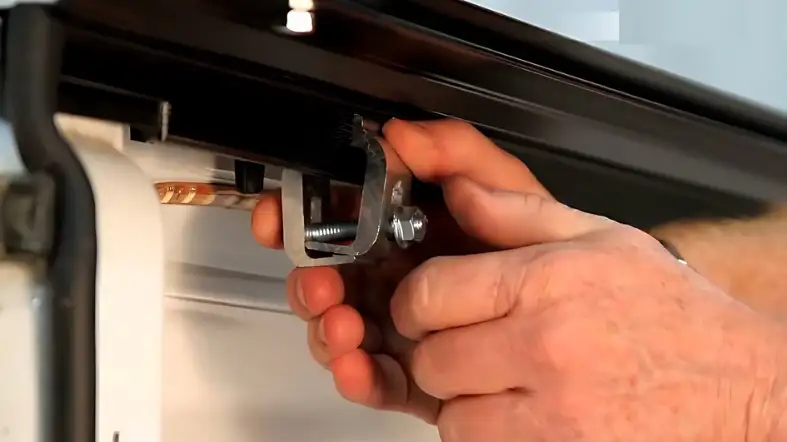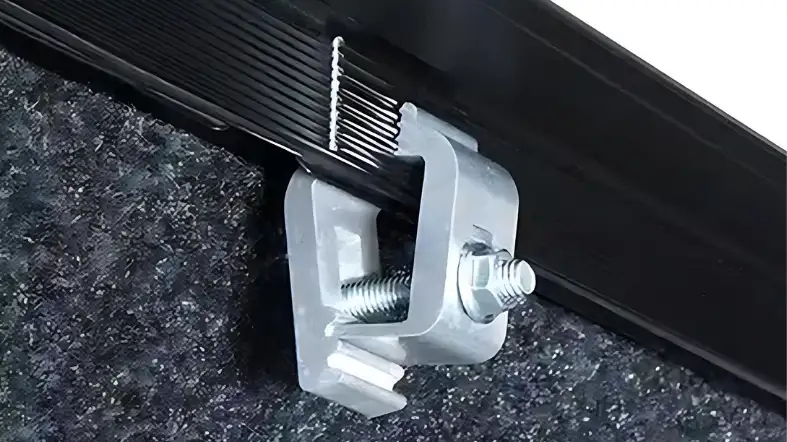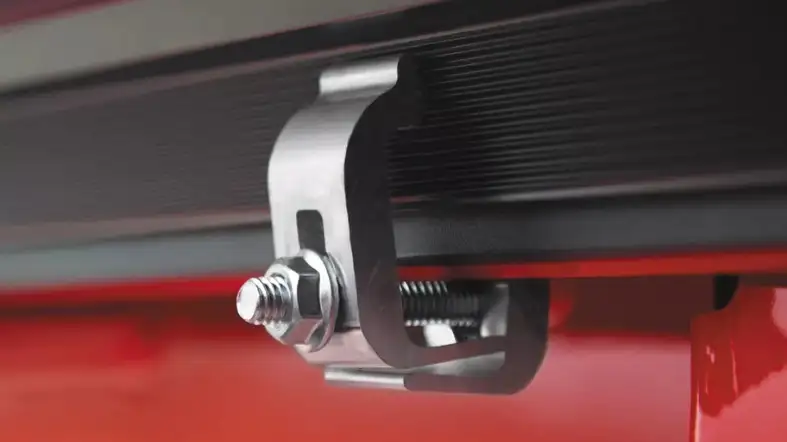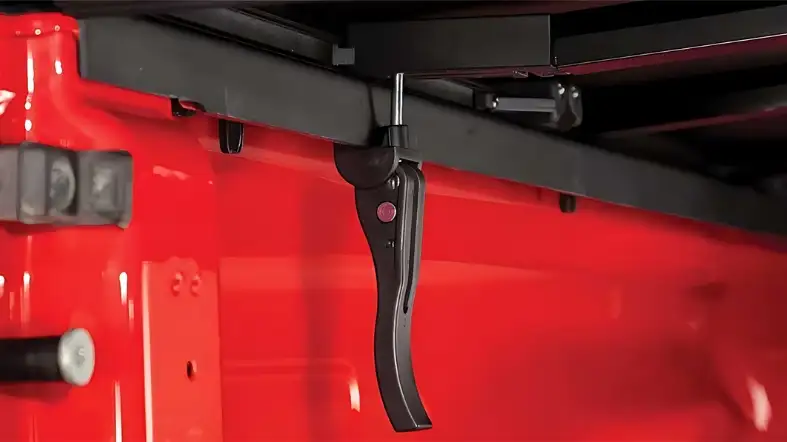Are you struggling to secure your tonneau cover effectively? Wondering how to properly clamp a tonneau cover for a snug and secure fit?
Look no further! In this article, we’ll provide you with a concise and informative guide on the best practices for clamping a tonneau cover.
Whether you’re a first-time tonneau cover owner or looking for tips to enhance your cover’s stability, we’ve got you covered.

How do you clamp a tonneau cover?
Follow these step-by-step instructions to clamp your tonneau cover effectively:
Step 1: Position the Tonneau Cover
First, position the tonneau cover over your truck bed, ensuring it aligns properly with the edges and fits snugly.
Make sure the cover is centered and extends evenly across the bed.
Step 2: Locate the Clamp Attachment Points
Next, identify the clamp attachment points on your tonneau cover. These points are typically located along the side rails or near the corners of the cover.
Check the manufacturer’s instructions if you’re unsure.
Step 3: Place the Clamps
Take the clamps provided with your tonneau cover and position them over the attachment points.
Each clamp consists of a bracket and a tightening mechanism. Align the bracket with the attachment point and make sure it sits securely.
Step 4: Tighten the Clamps
Once the clamps are in position, use the tightening mechanism to secure them in place.
This can be done by turning a knob or using a tool, depending on the type of clamp. Tighten the clamps until they are snug but not overly tight.
Step 5: Test the Security
After tightening the clamps, give the tonneau cover a gentle tug to ensure it is securely fastened.
If there is any movement or slack, readjust the clamps and tighten them further until the cover is firmly in place.
Step 6: Repeat the Process
Repeat the above steps for each clamp attachment point on your tonneau cover.
Make sure all clamps are tightened evenly to maintain a balanced and secure fit.
By following these simple steps, you can effectively clamp your tonneau cover, providing enhanced protection for your truck bed.
Remember to periodically check the clamps for any signs of looseness or wear, and readjust or replace them as needed.
Enjoy the peace of mind that comes with a securely clamped tonneau cover!
Benefits of Using Clamps for Your Tonneau Cover

Enhanced Stability and Security
Clamps provide a strong and secure attachment, keeping your tonneau cover firmly in place.
With clamps, you can prevent any shifting or movement of the cover, even when driving at high speeds or traversing rough terrains.
This stability offers peace of mind, knowing that your cargo is protected.
Quick and Easy Installation
Clamps are designed for ease of use, allowing for quick and hassle-free installation.
You don’t need specialized tools or expertise to attach the clamps to your tonneau cover.
Simply position them over the designated attachment points and tighten them securely. This convenience saves you time and effort.
Adjustable Tightness
Clamps offer the advantage of adjustable tightness. You can easily customize the tension of the clamps to achieve the desired fit for your tonneau cover.
This adjustability ensures a snug and tailored fit, accommodating different truck bed sizes and cover materials.
Versatility
Clamps are versatile and compatible with various tonneau cover styles, including folding, roll-up, and retractable covers.
Whether you have a soft or hard cover, clamps can secure them effectively. This versatility makes clamps a popular choice for tonneau cover installation.
No Drilling or Permanent Modifications
Using clamps eliminates the need for drilling or making permanent modifications to your truck bed.
Unlike some attachment methods that require drilling holes, clamps provide a non-invasive solution.
This ensures that your truck’s aesthetics and integrity are preserved, while still maintaining a secure tonneau cover attachment.
Easy Removal and Adjustments
If you need to remove or adjust your tonneau cover, clamps allow for effortless changes.
Simply loosen the clamps, make the necessary adjustments, and tighten them back in place.
This flexibility is particularly useful when you need to access the entire truck bed or modify the cover’s positioning.
Factors to Consider When Choosing Tonneau Cover Clamps

Consider the following factors to make an informed decision:
Tonneau Cover Type
The type of tonneau covers you have played a crucial role in determining the compatible clamps.
Different covers may require specific clamp designs or attachment methods.
Consider whether you have a folding, roll-up, retractable, or hinged tonneau cover to narrow down your options.
Material and Durability
Evaluate the material and durability of the clamps. Look for clamps made from high-quality materials such as stainless steel or aluminum.
These materials are known for their strength, resistance to corrosion, and longevity.
Ensure that the clamps can withstand various weather conditions and frequent use without deteriorating.
Attachment Points and Compatibility
Examine the attachment points on your tonneau cover and ensure they align with the clamp design.
Some tonneau covers have built-in attachment points, while others may require drilling holes or using brackets.
Verify that the clamps you choose are compatible with your specific cover and attachment system.
Adjustability and Fit
Consider the adjustability and fit of the clamps. Look for clamps that offer a range of adjustability to accommodate different truck bed sizes and cover materials.
This ensures a snug and secure fit. Check if the clamps have rubberized padding or grip to prevent damage to the cover and maintain a tight seal.
Ease of Installation
Evaluate the installation process of the clamps. Opt for clamps that are easy to install, requiring minimal tools and effort.
Some clamps feature a simple clamp-and-tighten mechanism, while others may have additional securing features.
Choose clamps that provide a user-friendly installation experience.
Brand Reputation and Reviews
Research the brand reputation and read customer reviews of the clamps you are considering.
Look for reputable brands known for manufacturing reliable and high-quality tonneau cover clamps.
Customer reviews can provide insights into the clamps’ performance, durability, and ease of use.
Price and Warranty
Consider your budget when choosing tonneau cover clamps. Compare prices among different brands and models, keeping in mind the quality and features offered.
Additionally, check if the clamps come with a warranty. A warranty can provide peace of mind, ensuring that you can seek assistance or replacement if any issues arise.
By carefully considering these factors, you can select the most suitable tonneau cover clamps for your specific requirements.
Comparison: Clamps vs. Other Tonneau Cover Attachment Methods
Let’s compare clamps with other common tonneau cover attachment methods to help you make an informed decision:
Clamps
Clamps are a popular choice for their ease of use and versatility. They offer quick installation, adjustable tightness, and compatibility with different tonneau cover types.
Clamps provide a secure and stable attachment without the need for drilling or permanent modifications to your truck bed.
Velcro Strips
Some tonneau covers use Velcro strips as an attachment method. Velcro offers simplicity and convenience, allowing for easy access to the truck bed.
However, Velcro may wear out over time and lose its adhesive strength, requiring replacement.
It may also be less secure compared to clamps, especially in windy conditions or at high speeds.
Snap Fasteners
Snap fasteners, also known as twist locks or buttons, are another common attachment method.
They involve snapping the cover into place using studs and sockets. Snap fasteners provide a secure attachment and can withstand strong winds.
However, they require manual fastening of multiple snaps, which can be time-consuming and may cause wear on the cover over time.
Latch Systems
Latch systems utilize locking mechanisms to secure the tonneau cover in place. They often require handles or levers to open and close the cover.
Latch systems offer a high level of security and durability. However, they may be more complex to operate compared to clamps and require additional steps for installation and removal.
Hinged or Locking Systems
Hinged or locking tonneau covers come with built-in hinges and locking mechanisms for added security.
These covers provide a seamless and integrated solution, often allowing for full or partial bed access.
However, they tend to be more expensive than clamps and may require professional installation.
Common Issues and Solutions with Tonneau Cover Clamps

While tonneau cover clamps are generally reliable and effective, you may encounter some common issues during their use.
Understanding these issues and their solutions will help you address any challenges that may arise. Here are some common issues and their corresponding solutions:
Loose Clamps
Problem: One common issue is clamps becoming loose over time. This can result from vibrations or changes in weather conditions, causing the tonneau cover to shift or flap.
Solution: To resolve this issue, periodically check the clamps and ensure they are tightened securely.
If you notice any looseness, adjust the clamps and tighten them further. You can also consider using additional securing measures, such as adding rubber padding or grip tape, to enhance stability.
Alignment Problems
Problem: Sometimes, clamps may not align properly with the attachment points on the tonneau cover, leading to an uneven or insecure fit.
Solution: Verify that the clamps are correctly positioned over the designated attachment points.
If misalignment persists, you may need to adjust the position of the clamps or consider alternative clamping options specifically designed for your tonneau cover type.
Cover Slippage
Problem: Occasionally, the tonneau cover may slip or move from its desired position, compromising its security and protection.
Solution: Ensure that the clamps are tightened adequately to prevent cover slippage.
Additionally, you can use friction pads or adhesive strips on the underside of the tonneau cover to increase traction and reduce the likelihood of slippage.
Corrosion and Rust
Problem: Over time, clamps may be exposed to moisture and harsh environmental conditions, leading to corrosion and rust formation.
Solution: Choose clamps made from corrosion-resistant materials, such as stainless steel or aluminum.
Regularly inspect the clamps for signs of rust or corrosion and promptly address any issues.
Applying a protective coating or lubricant to the clamps can help prevent corrosion.
Maintaining and Caring for Tonneau Cover Clamps
Regular Cleaning
To prevent dirt, debris, and grime buildup, regularly clean your tonneau cover clamps.
Use a mild soap or a dedicated cleaner suitable for the clamp material.
Gently scrub the clamps with a soft brush or cloth, paying attention to crevices and hard-to-reach areas. Rinse thoroughly and allow them to dry completely before reattaching.
Lubrication
Periodically lubricate the moving parts of the clamps to ensure smooth operation. Apply a silicone-based lubricant or a lubricant recommended by the manufacturer.
Lubricate any hinges, tightening mechanisms, or adjustable components to reduce friction and maintain the clamps’ functionality.
Inspection
Regularly inspect the clamps for any signs of wear, damage, or corrosion. Check for loose screws, bent brackets, or worn-out components.
If you notice any issues, address them promptly. Tighten loose screws, straighten bent brackets, or replace damaged parts to maintain the clamps’ effectiveness.
Protection from Corrosion
To prevent corrosion and rust formation, protect your clamps from moisture and harsh environmental conditions.
Consider applying a protective coating or a rust inhibitor to the clamps.
Additionally, avoid exposing the clamps to corrosive substances such as saltwater or chemicals.
If the clamps show signs of corrosion, clean them thoroughly and apply an appropriate rust remover or inhibitor.
Secure Storage
When not in use, store your tonneau cover clamps in a secure and dry location. Keep them away from extreme temperatures, direct sunlight, or excessive humidity.
Consider storing them in a designated box or container to protect them from potential damage or misplacement.
Regular Adjustment
Periodically check the tightness of the clamps and readjust if necessary. Over time, vibrations and changes in temperature may cause the clamps to become loose.
Ensure that the clamps are securely tightened to maintain a tight fit and prevent any potential movement or slippage of the tonneau cover.
Is it Difficult to Remove a Tonneau Cover with Clamps?
One of the easiest tonneau cover removal methods is utilizing clamps. However, the question arises: is it difficult to remove a tonneau cover with clamps? Well, not at all. With the right technique, removing a tonneau cover using clamps is a breeze. Simply release the clamps and carefully lift the cover off the truck bed. Voila! Easy removal in no time.
FAQs
Do I Need Any Tools To Clamp A Tonneau Cover?
No, clamping a tonneau cover typically doesn’t require any specialized tools. Most clamps can be tightened by hand or with a basic wrench.
Can I Clamp A Tonneau Cover By Myself, Or Do I Need Assistance?
You can easily clamp a tonneau cover by yourself. The process is straightforward and doesn’t usually require any additional help.
How Tight Should The Clamps Be When Securing The Tonneau Cover?
The clamps should be tightened until they are snug, ensuring a secure fit.
Avoid overtightening, as it may damage the tonneau cover or its attachment points.
Are Clamps A Universal Attachment Method For All Tonneau Covers?
Clamps are a widely used attachment method, but their compatibility may vary depending on the tonneau cover type and brand.
Always check the manufacturer’s recommendations for your specific cover.
Can I Adjust The Position Of The Clamps After Installation?
Yes, you can adjust the position of the clamps if needed. Loosen the clamps, reposition them as desired, and then tighten them securely.
How Often Should I Check And Retighten The Clamps On My Tonneau Cover?
It’s a good practice to periodically check the clamps and ensure they remain securely tightened.
Factors such as temperature changes and vibrations can cause them to loosen over time.
Regularly inspecting and retightening, if necessary, will help maintain a secure tonneau cover attachment.
Final Words
Now that you know how to clamp a tonneau cover, securing your truck bed has never been easier.
By following the simple steps of positioning, attaching, and tightening the clamps, you can ensure a snug and secure fit for your tonneau cover.
With the right clamping technique, you can protect your truck bed and its contents from potential damage, ensuring peace of mind on every journey.
